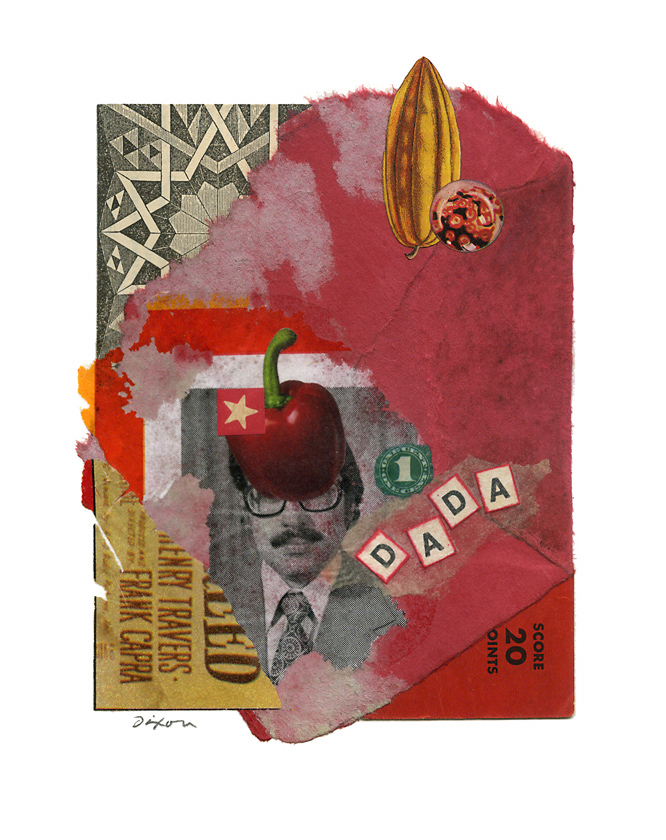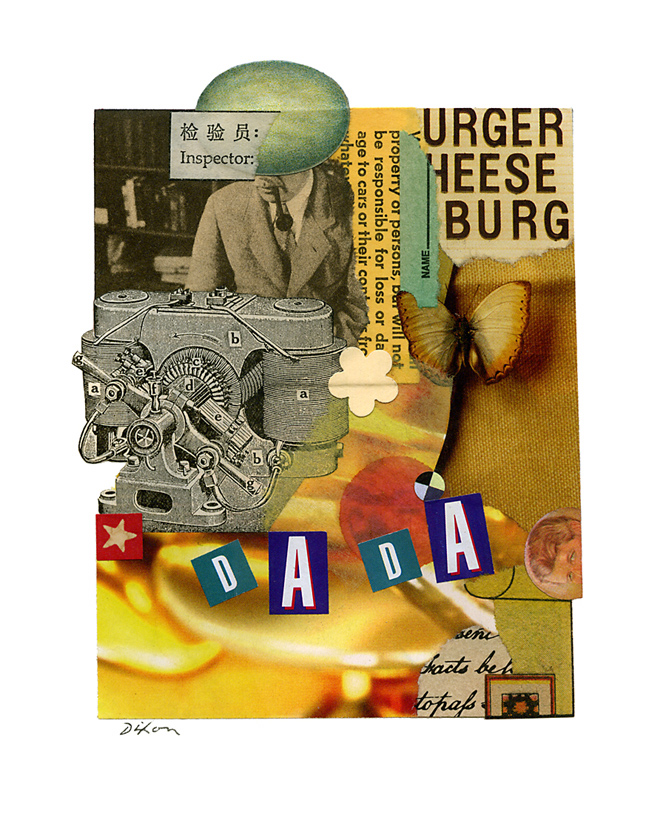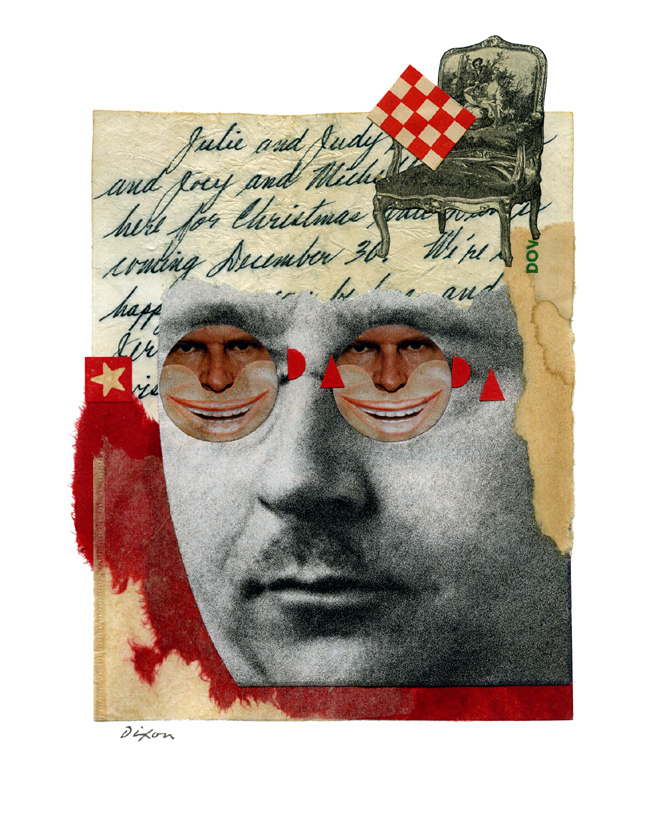Archive for the ‘Dada’ Category
Friday, August 23rd, 2024
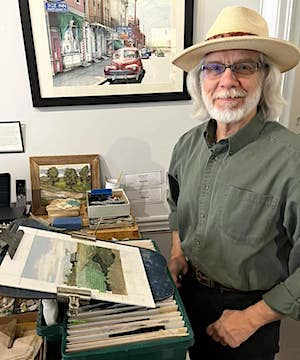

Dixon appears again at Art Space Versailles, hopeful that a buyer might be interested in the collage artwork called Renewal.
I scheduled a double event this week and it was a fine way to saddle up and ride a momentum. I was eager to point out that Renewal was on consignment at Art Space Versailles.
The studio piece began with my musing on the cyclic life of trees, which makes sense because I’m endlessly fascinated by them and since I work primarily in papers after all. Most collage artists are scroungers at heart, so I had turned to my stash, searching for potential ingredients. I found more than enough for a 12×12-inch canvas and intuitively assembled a “ground” of these found images. I think that toward the end of the process it had became as much an abstract composition as an interpretation of my thematic idea. I didn’t want it to appear too abstract or purposely surreal, so, at the closing stage, I crafted a literal seedling from individual paper components, more in the representational manner that I use for collage en plein air. I guess one could say that the culminating element pictured the birth of a tree, but, as with all life cycles, who can say when the beginning or ending actually occurs. The art itself is re-purposed paper, a clear ending for a tree, at least until inevitable decomposition takes place, and then another cycle of renewal carries on.
In contrast, the exercise in spontaneity featured below had no preconceived intent and originated as a demo miniature during my exhibition-related workshop at Paul Sawyier Public Library in Frankfort on Tuesday. I refined and completed it last night during the appearance in Versailles as a guest artist. The unfinished piece had been immediately titled by a workshop participant after the primary ingredients were juxtaposed, and I just couldn’t top her suggestion!
It joins countless other artworks that tip the Pop-ist hat to Andy Warhol (Campbell’s Soup) or Ray Johnson (Lucky Strike). But the grandfather of Pop Art was Kurt Schwitters. So much of contemporary collage is, in essence, an homage to the German innovator, and I never tire of working in the Merz tradition that he pioneered a hundred years ago.

Kick the Can
collage experiment by J A Dixon
7 x 8.5 inches
Posted in 1) Available!, A Warhol, Collage, Dada, Demonstrations, Exhibitions, Experiments, Homage, Ingredients, J A Dixon, K Schwitters, Merz, Pop Art, R Johnson, Titles | No Comments »
Monday, January 27th, 2020
“When Schwitters made the first collage by literally picking up a piece of rubbish, a sweet wrapper, a bus ticket and a piece of wood, that was pure invention.”
— Sir Peter Blake
For the many who revere his art, there’s a distinct Kurt Schwitters for each of us — rebellious creator, fearless performer, relentless out-of-the-boxer, proto-beatnik, or visionary theorist. In combination with his towering individualism, he was, by reports from those who knew him, affable, witty, optimistic, entertaining, and a practical joker. This is the Kurt who would be a pleasure to “hang” with, who others in the internment camp on the Isle of Man would hear each morning, barking like a dog.  In our local Bluegrass culture, there is a phrase for such a character. Around these parts, he likely would’ve been known as a “good ol’ boy.”
In our local Bluegrass culture, there is a phrase for such a character. Around these parts, he likely would’ve been known as a “good ol’ boy.”
In response to the international call by Ric Kasini Kadour to build a Schwitters’ Army collection at MERZ Gallery, the two pieces I created pay tribute to this particular K.S. Both were fashioned from street debris and highway litter accumulated from my immediate vicinity. One of them was mailed to Sanquhar, Scotland. I haven’t decided what to do with “part 2.” Perhaps the series will continue.
In 2016, I wrote the following in my published essay on a hundred years of Dada: “Those of us who create collage art may not always describe our works as a tribute to the enduring, inclusive concepts of Merz, but that is precisely what they are, and we are indebted to that legacy.” As one who has never wearies of exploring the far-reaching innovations of K.S., I am content to describe myself unabashedly as a working “Merzologist.”
Schwitters may or may not have been the original artist to embed found detritus in collage, but certainly he was the first to fully master a modern-art version of the medium when it emerged at the close of the Great War. Embracing every conceivable source ingredient, he would codify the new visual vocabulary, give it an umbrella name, and bequeath the methodology to unborn generations. 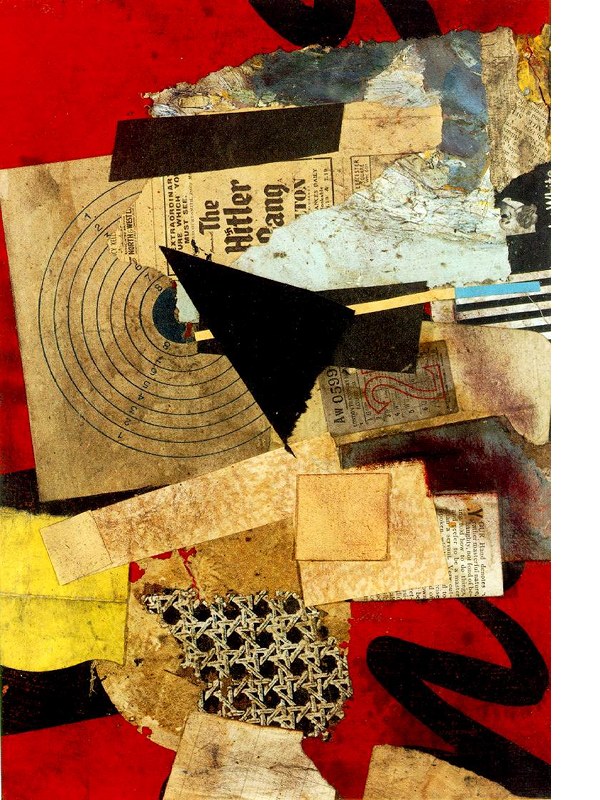 He may have sensed that the window of opportunity for him to preside over such a grand human venture was closing. He never got to take by storm the art world of 1950s New York — something eminently suited to his personality. His work and writings have had to speak for themselves.
He may have sensed that the window of opportunity for him to preside over such a grand human venture was closing. He never got to take by storm the art world of 1950s New York — something eminently suited to his personality. His work and writings have had to speak for themselves.
For me, the seminal creations that launched what we know as Merz can never be separated from the man himself — the one who directed subtle, irreverent jabs toward a gang of thugs who hijacked his culture, until it was impossible to stay put, and then, after facing further persecution in Norway with his son, reckoned that an icebreaker just might evade Nazi torpedoes long enough for them to reach the coast of Scotland. Probably that dauntless, wry, “Good Ol’ Boy” side of him was satisfied to leave us with this simple thumbnail declaration:
“My name is Kurt Schwitters.
I am an artist and I nail my pictures together.”
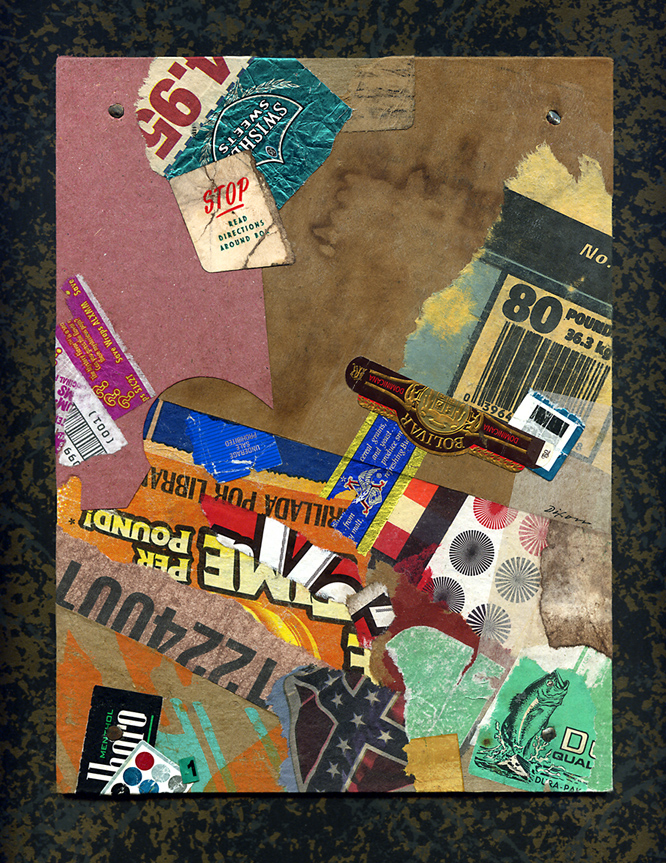
Good Ol’ Boy Dada, part 1
collage artifact by J A Dixon
7 x 9.25 inches
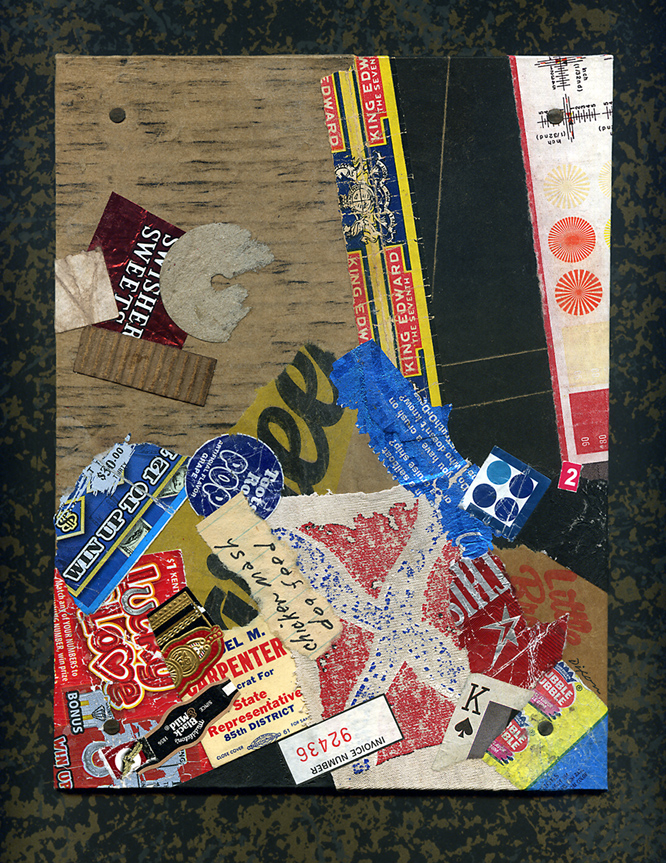
Good Ol’ Boy Dada, part 2
collage artifact by J A Dixon
7 x 9.25 inches
Posted in Artifacts, Collage, Dada, Homage, Influences, Ingredients, J A Dixon, K Schwitters, Merz, Methodology, R K Kadour | 1 Comment »
Sunday, November 17th, 2019
“For some time, we have been inspired by the work of mr.babies. He frequently uses large eyes and sweeping vistas. His work, while expressive and multicolored, also hints at the human longing for place. mr.babies is known for posting a series of images that integrate one shared element placed on a variety of backgrounds At the end of the series, the viewer often finds the completed piece. To us, this visually represents the (often lifelong) journey to find belonging.”
— Doug + Laurie Kanyer
Kindly take a look at my submission to the OPEN CALL opportunity by the Doug + Laurie Kanyer Art Collection on the theme of “finding a place of my own.” The Yakima-based couple are building a repository of contemporary collage and using Instagram, ![]() Facebook, and other devices to elevate their agenda in the art world.
Facebook, and other devices to elevate their agenda in the art world.
My take on this idea is to turn inward on the medium of collage itself, with a veteran “Merzologist” mentoring his young protégé on the intricacies of the Kurt Schwitters legacy.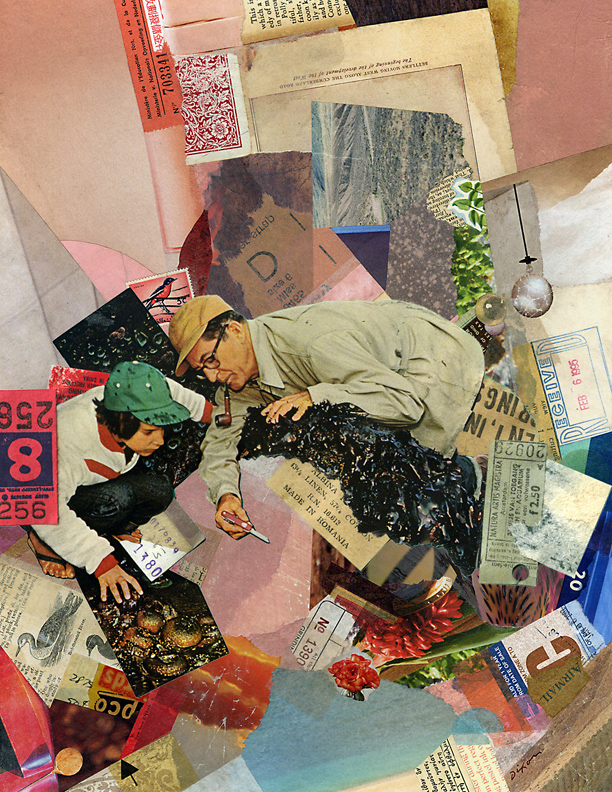 I’ve explored placing the central element against different backgrounds from my previous compositions, according to the constraints of the project. A final pasted version integrates the same subject within an entirely new “terrain” of ingredients created specifically for the entry. It’s my first official salute to a hundred years of Merz — in all likelihood, the most pioneering concept in the history of collage.
I’ve explored placing the central element against different backgrounds from my previous compositions, according to the constraints of the project. A final pasted version integrates the same subject within an entirely new “terrain” of ingredients created specifically for the entry. It’s my first official salute to a hundred years of Merz — in all likelihood, the most pioneering concept in the history of collage.
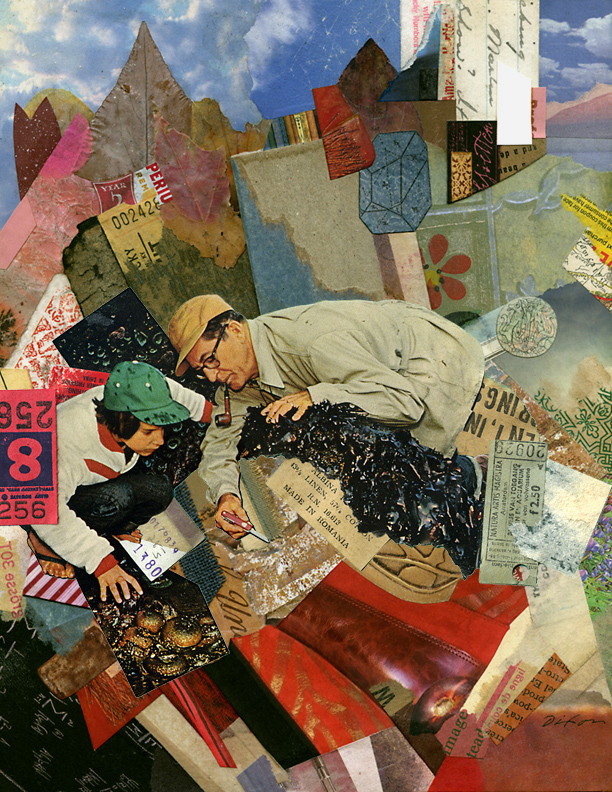
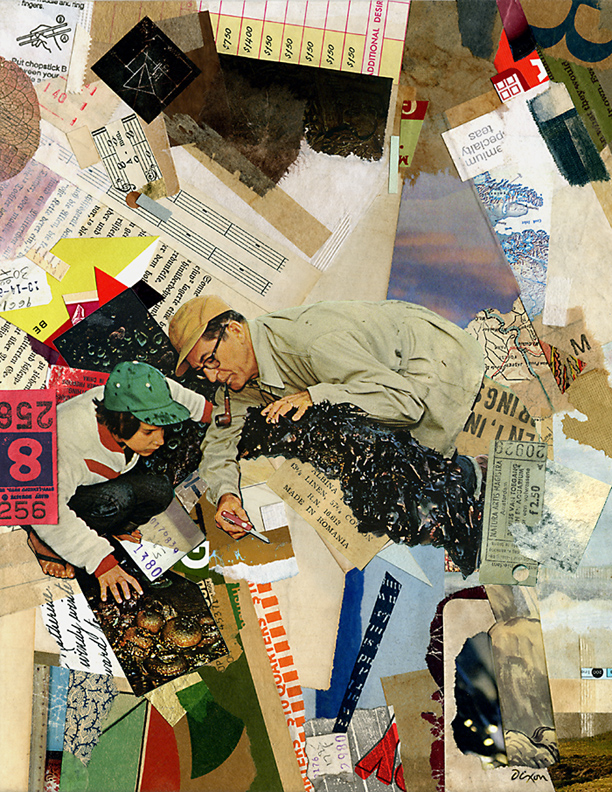
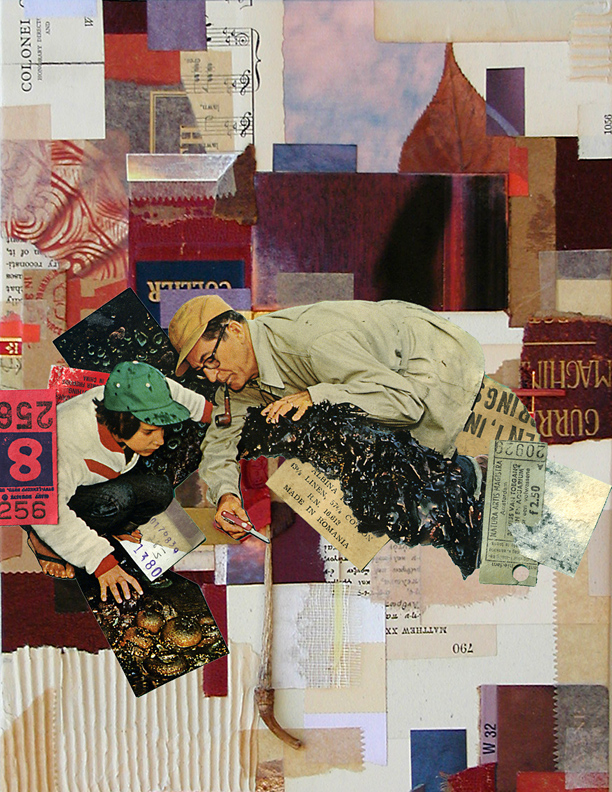
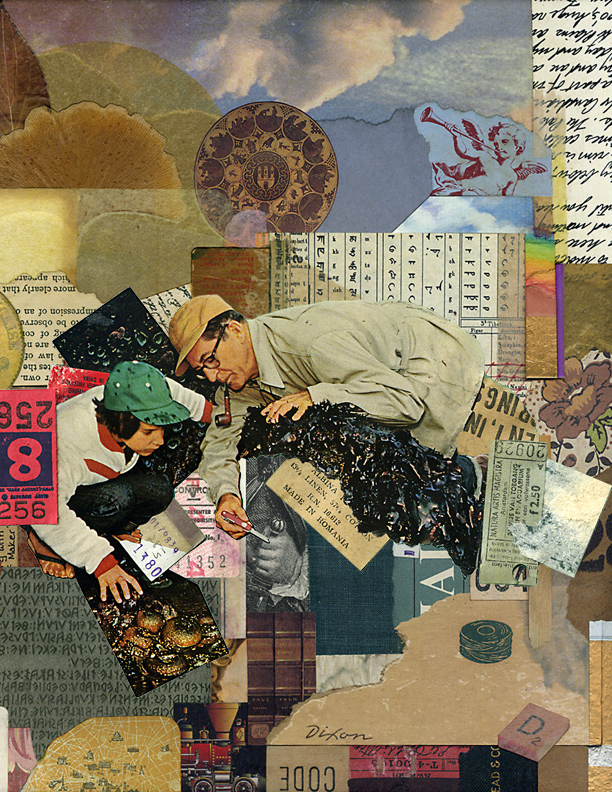
As an artist, Merz means more to me than finding a place of my own. In the words of the great innovator, it is about “creating relationships, preferably between all things in the world.” I know that I’ve used the quotation a number of times at this site, but is it not as true today as it ever has been? Upwards of 500 works have been submitted to the Kanyer exercise from artists worldwide, another indication of how collage has exploded in the emerging era of social networks.
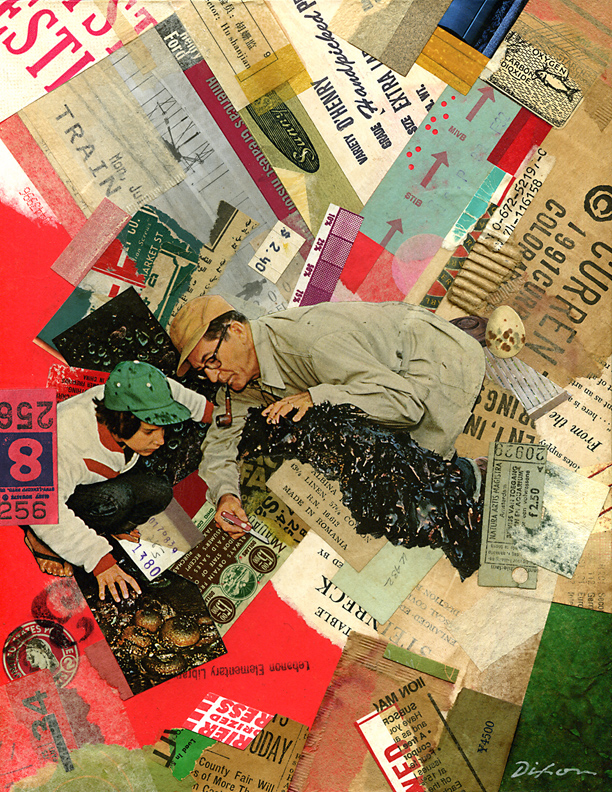
The Apprentice Merzologist
collage on book cover by J A Dixon
8.5 x 11 inches
part of the #findingaplaceofmyown project
Posted in Abstraction, Collage, Constraints, Dada, Influences, J A Dixon, K Schwitters, L Kanyer, Merz, Theme/Variation | No Comments »
Tuesday, August 6th, 2019
“Anger is a very limiting emotion. There’s not much you can do with it. There’s no hope in it.”
— Wendell Berry
There was a time when the arts may have held the capacity to alter the world around us. From time to time, music probably has. Perhaps the dramatic arts, too. The oral and written arts of language certainly have, and they remain highly consequential, but the notion that those engaged in artistic “visual statements” can affect society is an illusion. The early 20th-century avant-garde believed they could, and maybe they did to some limited extent, while the attention of a less distracted elite was seized. At any rate, this innovative class took what they had absorbed, rejected much of it, and cultivated the vocabulary of the modern art forms which influence the bulk of what artists do today. And almost all of what we do now has very little if any catalytic effect on evolving civilization — especially if it was overtly intended to do just that. But make no mistake about it, “message art” has been, is, and can be a significant catharsis for creative individuals. Rest assured that it will reinforce solidarity among people of like mind. It can also be relied upon to irritate many of the others.
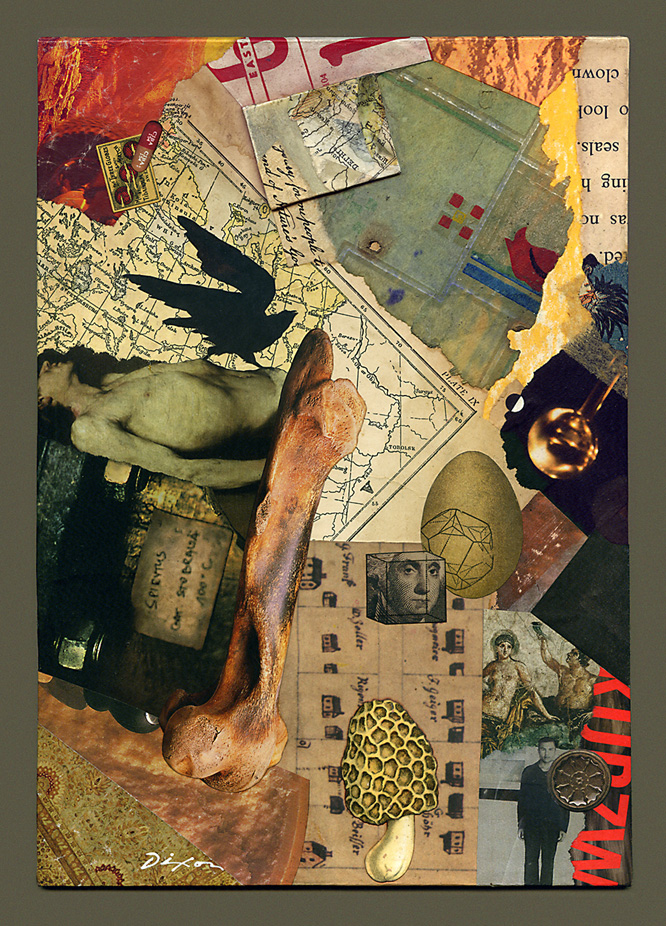
Taboo Faction
collage catharsis by J A Dixon
8.125 x 11.5 inches
Purchase this artwork.
Posted in 1) Available!, Catharsis, Constructivism, Criticism, Cubism, Dada, Influences, J A Dixon, Merz, Music, Surrealism, W Berry | No Comments »
Tuesday, September 18th, 2018
Sharing a major announcement in the world of collage and assemblage: The Ontological Museum has undertaken an entire makeover of its online archives. Let all doff their hats to Cecil Touchon!
Beware — connoisseurs of the collage medium can be swept into this magnificent black hole of imagery. Just a few outstanding examples are featured below.
Fellow collage artists, it is up to us to grow and preserve this extraordinary collection. Become a subscribing member!
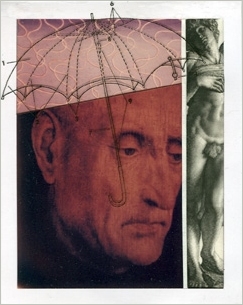
The Sun Always Shines on TV
collage artwork by Cory Peeke, 2010
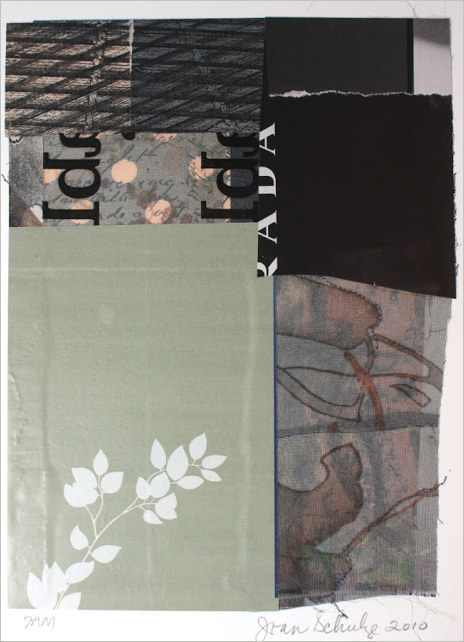
7 am
collage artwork by Joan Schulze, 2010
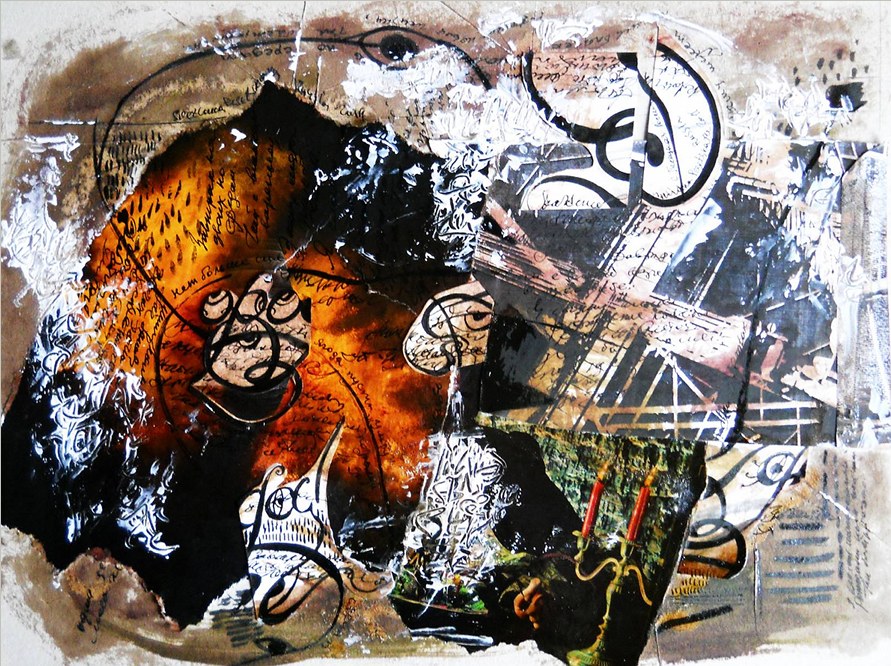
Ritual 2
mixed-media collage by Svetlana Pesetskaya, 2011
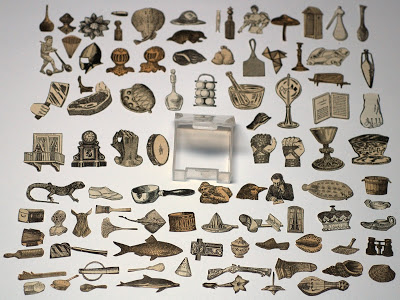
Case #10
small things by Hope Kroll for Fluxcase Micro Museum, 2011
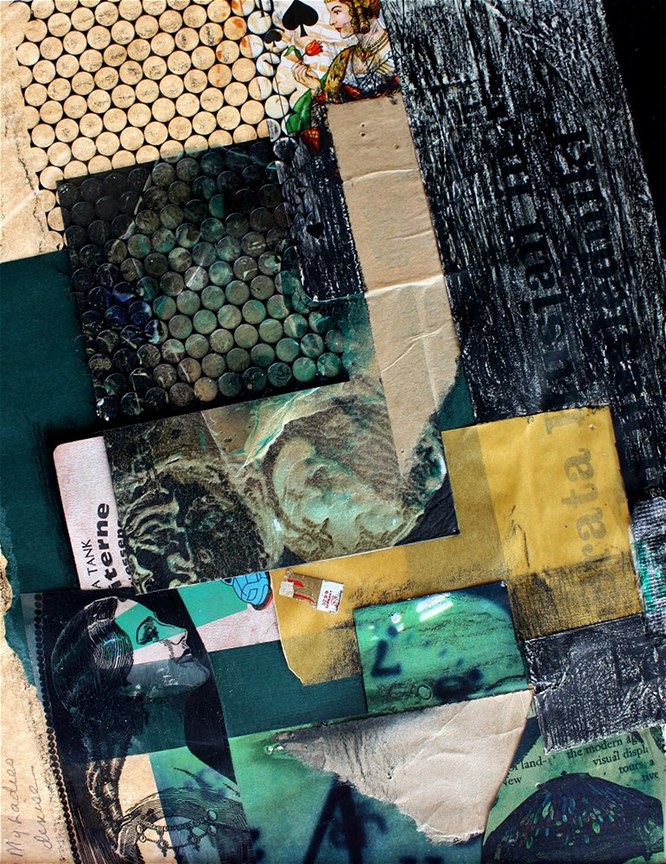
(title unknown)
mixed-media collage on paper by Denise Pitchon, 2012
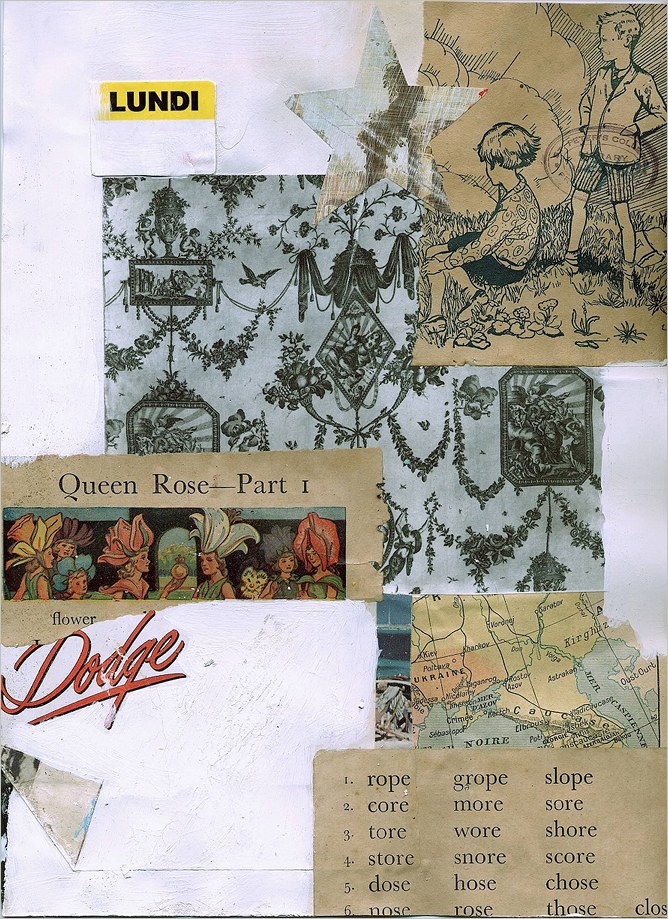
Queen Rose Score
collage on paper by Matthew Rose, 2012
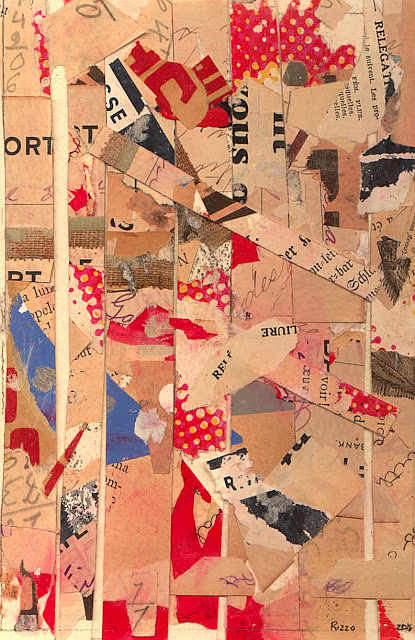
(title unknown)
collage for Dada Centennial by Bob Rizzo, 2016
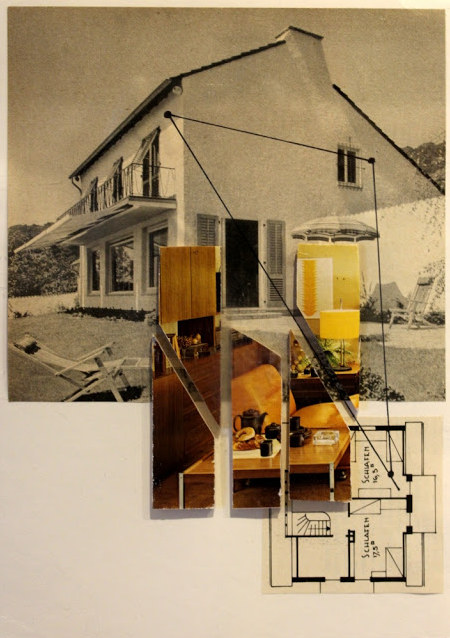
Homage to Merzbau
collage artwork by Sabine Remy, 2016
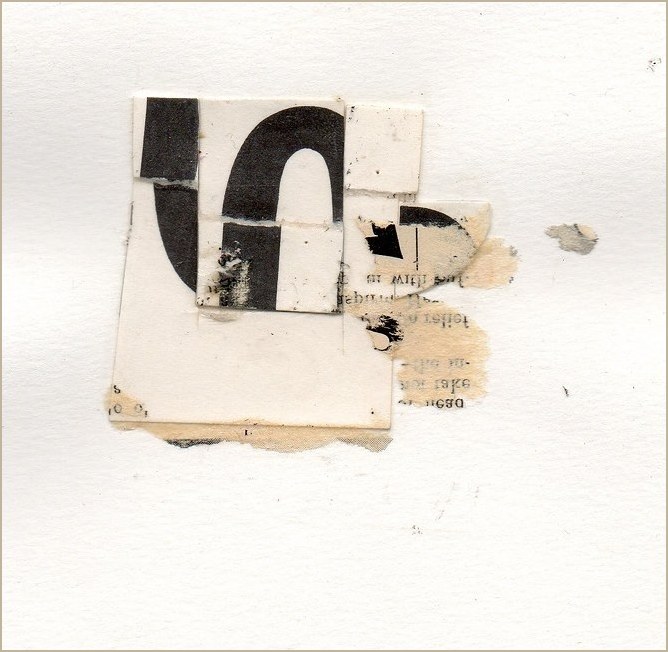
(title unknown)
asemic collage on paper by Jim White, 2018
(images courtesy of The Ontological Museum)
Posted in B Rizzo, C Peeke, C Touchon, Collage, D Pitchon, Dada, Fluxus, H Kroll, J Schulze, J White, Links, M Rose, Merz, Museums, S Pesetskaya, S Remy | 1 Comment »
Tuesday, August 21st, 2018
“We do not analyze works of art because we want to imitate them or because we distrust them.”
— Paul Klee
The other day the world learned about an unpublished Ernest Hemingway short story. If there had not been a Mark Twain first, would literature know Hemingway’s writings at all? Could there have been an Isaac Asimov, Stan Lee, or Gene Wolfe without a Verne or Burroughs? The J.K. Rowling body of work without an Austen or Tolkien? 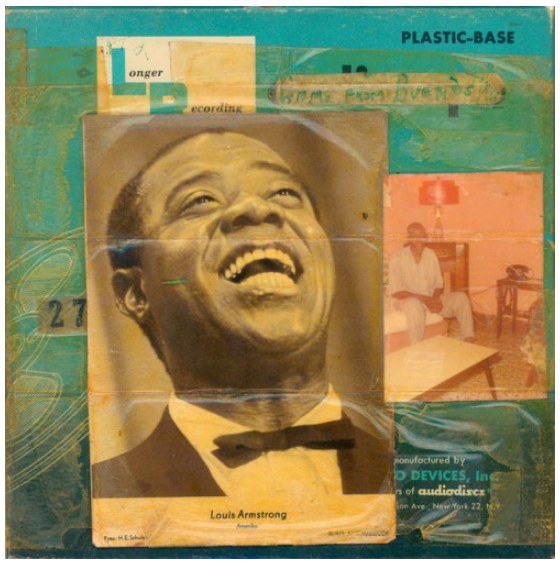 Similarly, all of today’s rock music can be linked to direct influences — to bands such as Ramones, Led Zeppelin or the Beatles, which, of course, had their own precursors. Would jazz exist in its current form without the innovations of Armstrong and all those who inspired him? Imagine a contemporary musician saying, “I really haven’t paid attention to any music that was recorded before I started to play.” And yet, not infrequently, collage artists will boast that they have little use for art history (all the breakthroughs of bygone creators who dug the swimming pools in which they now frolic).
Similarly, all of today’s rock music can be linked to direct influences — to bands such as Ramones, Led Zeppelin or the Beatles, which, of course, had their own precursors. Would jazz exist in its current form without the innovations of Armstrong and all those who inspired him? Imagine a contemporary musician saying, “I really haven’t paid attention to any music that was recorded before I started to play.” And yet, not infrequently, collage artists will boast that they have little use for art history (all the breakthroughs of bygone creators who dug the swimming pools in which they now frolic).
It is argued that modern artists were the first to decide that visual art would be about art, rather than subject matter. Nonsense. Art has always been about art, because it always has been structured on prior foundations. The idea that any artist can burst on the scene as an original is absurd. Nobody who comes out of early childhood with any level of awareness has not built an inventory of perceptions — countless images from the culture around them. Each of these individual influences involved creative activity based on another bank of stimuli, and so forth, back to the first proto-human who picked up a piece of charcoal to make interesting marks on a stone (and was probably knocked on the head by another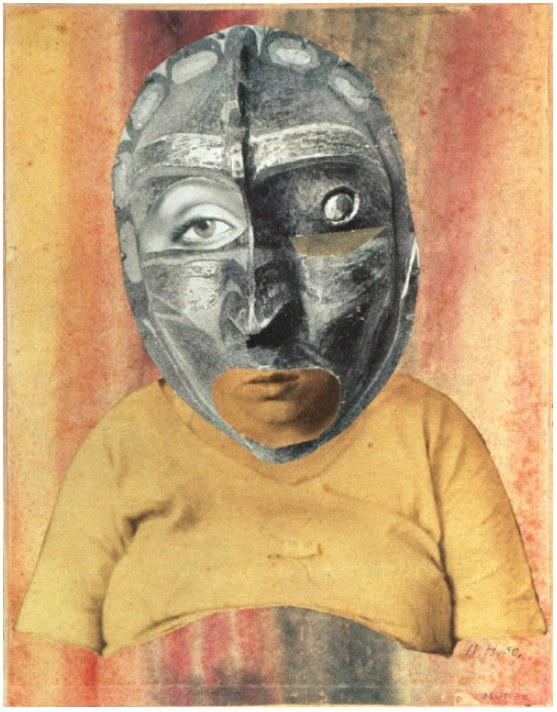
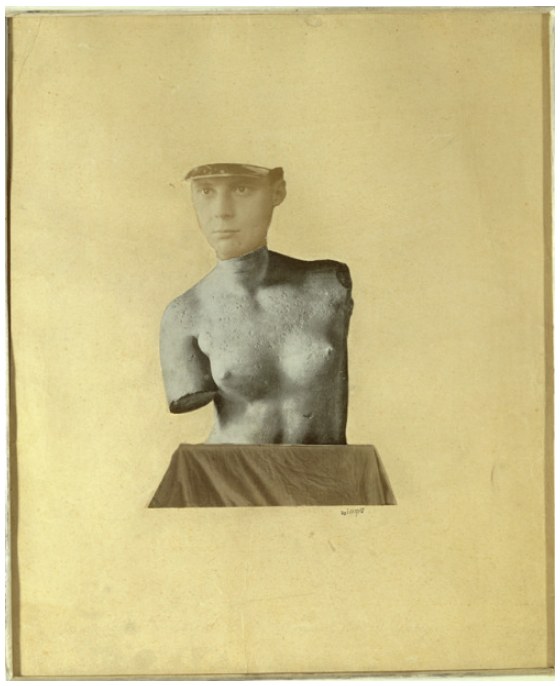 who judged the action as irrelevant to group survival).
who judged the action as irrelevant to group survival).
Perhaps I have belabored my point. Perhaps it is a point that anyone who reads this would not need emphasized in the first place. Isn’t it obvious to us that no art form is more about all these churning influences from untold visual decision makers — painters, printers, illustrators, photographers, designers — than the medium of collage itself? So, let us all continue to study the collage artworks of the explorers who came before us, to trace the direct lineage of their concepts and techniques, to recognize that valuable inheritance in the work of our peers, as well as in the composition taking shape on the surface before us, and then, fully informed, to push confidently into the second century of collage.
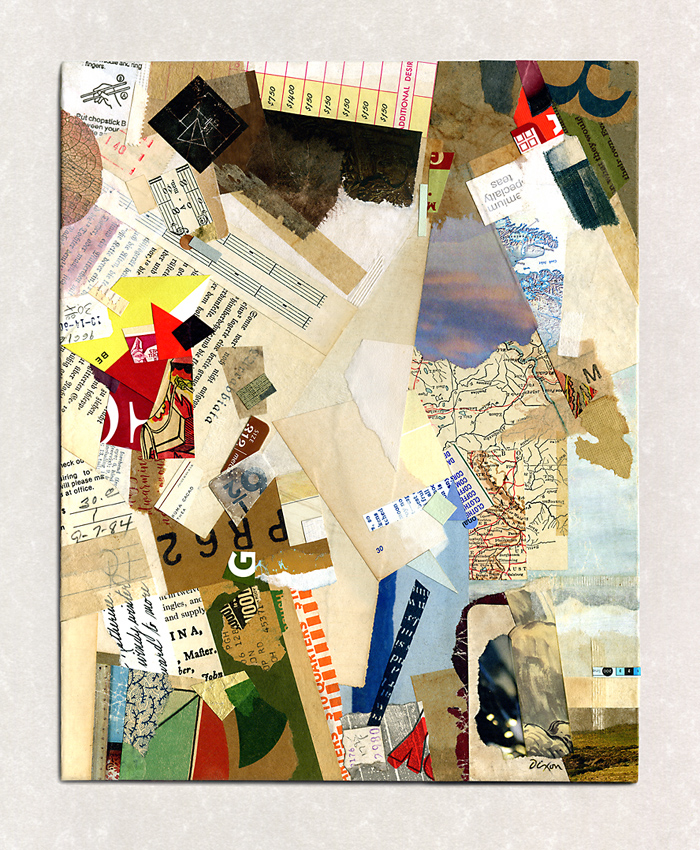
Tranquil Ode (to Merz)
collage homage by J A Dixon
9.5 x 11.875 inches
Purchase this artwork.
Posted in Abstraction, Applied Arts, Collage, Criticism, Cubism, Dada, Fluxus, Graphic Design, H Höch, Homage, Illustration, Influences, J A Dixon, J T Baargeld, K Schwitters, Literature, M Twain, Merz, Music, P Klee, Priorities, Surrealism | No Comments »
Saturday, March 17th, 2018
“Schwitters began making collages in 1918 and produced them in large numbers for the remainder of his career. In 1919 he began using the term ‘Merz’ (which originated from the German word ‘Kommerz’, meaning ‘commerce’) to describe his principle of assembling found materials.”
— Louise Hughes
Das Kirschbild — a fitting followup for the previous entry on abstraction.
And for those of us who never tire of learning new things about the incomparable Master of Merz:
• from the Armitt Museum Collection in the Lake District
• from the Tate Britain
• from the Guggenheim
• from the Sprengel Museum Hannover

Merzbild 32 A. Das Kirschbild
Kurt Schwitters, 1921
The Museum of Modern Art, New York
Posted in Dada, Influences, K Schwitters, Links, Merz, Museums | No Comments »
Saturday, January 13th, 2018
“I have always tried to exploit the photograph. I use it like color, or as the poet uses the word.”
— Hannah Höch
It is always a temptation for a so-called blogger to dangle a “best of” or “top twenty” list to entice a visitor, and, of course, we see this tactic used almost on a daily basis in various fields of art and entertainment. How many of us have gone online and swallowed just such a colorful lure? On the most obvious level, the whole stimulus-response thing is a bit silly, but the potential to learn something new does exist, or to sharpen our own sense of quality, preference, and discernment. Each of us is free to have viewpoints, as long as we recognize them as personal opinions, and avoid casting them about as certitude. Isn’t there enough of that going on these days? (Yes, dear guest, that is merely my perspective.) 
What does this have to do with collage? Well, I just paid a visit to a page at AnotherMag.com (in response to the aforesaid bait), and I learned for the first time about three collage artists who were new to me, a working artist who purports to ruminate on “all things collage.” In this particular case, there may have been an explicit effort to achieve an overdue gender balance for a post intended to spotlight the Höch retrospective at the Whitechapel Gallery in London, but one could question the absence of Paolozzi, Rauschenberg, Johnson, Hamilton, or Kolář. To not include at least one of these men as a key figure in the history of collage brings no meaningful discredit on any of the artists, but only on the list. (And that, too, is just my opinion).
Nevertheless, I am not ashamed to accentuate the gaps in my collage literacy and to feature three noteworthy female artists: Eileen Agar, Nancy Spero, and Annegret Soltau. Examples of their work should have appeared here long before now.

Woman reading
by Eileen Agar, 1936
Museum of New Zealand

Protagonists
by Nancy Spero, 1989
disposition unknown

Grima – mit Katze
by Annegret Soltau, from her 1986-97 series
Vero Group Collection, Houston, Texas
Posted in A Soltau, Assemblage, Collage, Criticism, Dada, E Agar, E Paolozzi, Exhibitions, G Braque, H Höch, Influences, J Cornell, J Kolář, J Stezaker, J Treece, K Schwitters, Links, M Ray, Merz, N Spero, P Donley, R Hausmann, R Johnson, R Rauschenberg, Surrealism | No Comments »
Sunday, May 7th, 2017
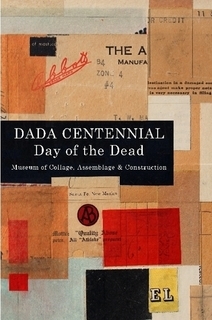 It is with high anticipation that I await my first look at the new publication which documents the Dada Centennial exhibition organized by the Ontological Museum. My sincere thanks to Cecil Touchon for including the essay that I wrote last year — On Kurt Schwitters and a Century of Dada — but, most of all, for volunteering so much of his time to this historic observation and to the ongoing administration of the institution he founded, now located in Santa Fe, New Mexico.
It is with high anticipation that I await my first look at the new publication which documents the Dada Centennial exhibition organized by the Ontological Museum. My sincere thanks to Cecil Touchon for including the essay that I wrote last year — On Kurt Schwitters and a Century of Dada — but, most of all, for volunteering so much of his time to this historic observation and to the ongoing administration of the institution he founded, now located in Santa Fe, New Mexico.
The exhibition at the archives of the International Museum of Collage, Assemblage and Construction opened on November 4, 2016 and lasted through January 31, 2017. A worldwide array of Dada-inspired artists sent artworks for the show that will be added to the permanent collection. They are all displayed in the full-color, 275-page catalog that is available for purchase. A “Merz Painting” by Peter Dowker is featured on the cover. In addition to my essay, the publication has an introduction by Touchon, another essay by Drager Meurtant, Birth of Merz by Schwitters, original verse by Dada artists, writings by Hugo Ball, three of my experimental miniatures, and collage art by some whose work I have spotlighted here at TCM, including Dowker, Hope Kroll, Zach Collins, Nikki Soppelsa, Erin Case, Joel Lambeth, Melinda Tidwell, Evan Clayton Horback, and Katrien De Blauwer.
When I experienced the milestone Schwitters exhibition at the Berkeley Museum of Art in 2011, I failed to bring home the forty-dollar catalog. When I got back to Kentucky, I discovered that the compendium was already worth $200. I do not know what long-term plan the Ontological Museum has for this publication, but it may not always be available. Go online, take advantage of the current discount, and buy it now.
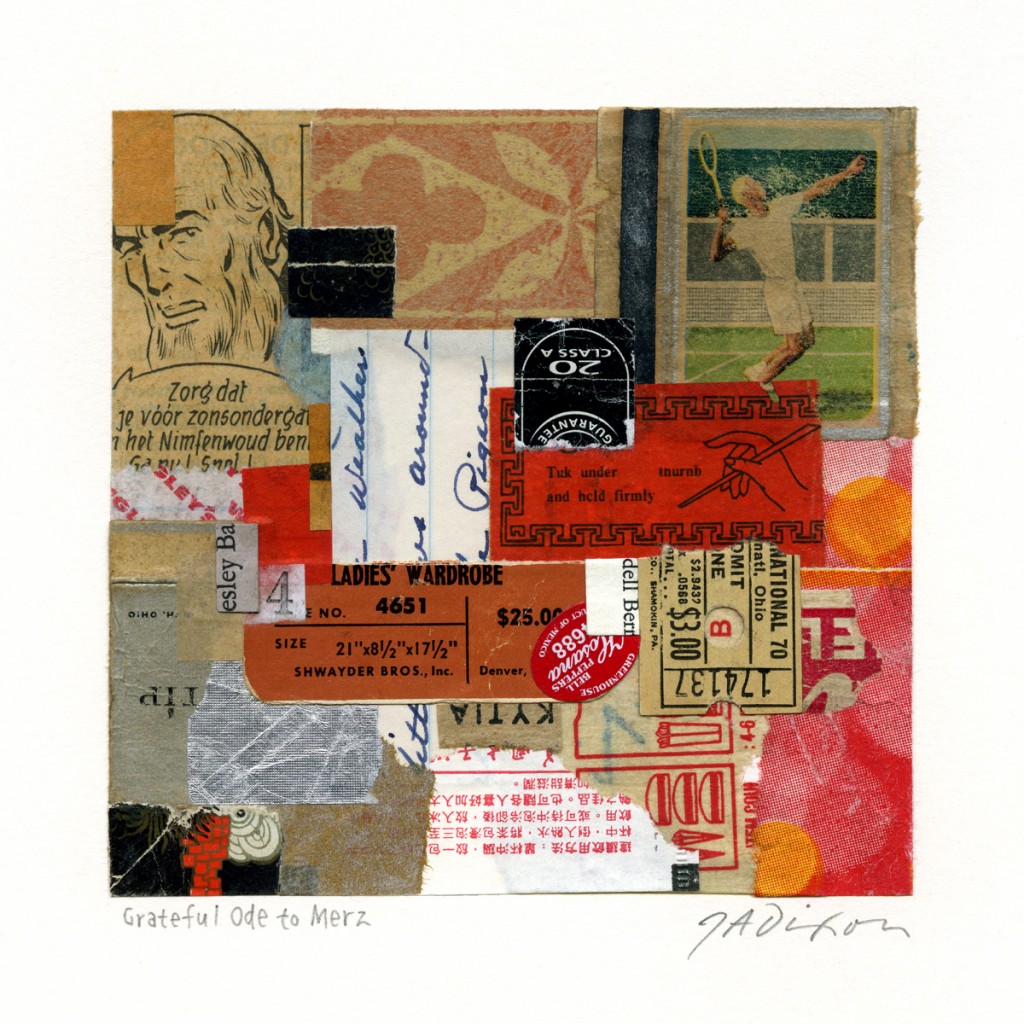
Grateful Ode to Merz
collage miniature on Bristol by J A Dixon
homage to Kurt Schwitters
collection of The Ontological Museum
Posted in C Touchon, Collage, Dada, E C Horback, E Case, Exhibitions, H Kroll, J A Dixon, J Lambeth, K De Blauwer, K Schwitters, M Tidwell, Merz, Museums, N Soppelsa, P Dowker, Publications, Z Collins | No Comments »
Sunday, March 5th, 2017
“If you’re coasting, you’re going downhill.”
— L W Pierson
Awhile ago, someone asked a question about the trajectory of collage: “What’s Next?” To ponder that, I remind myself that one thoughtful critique is worth more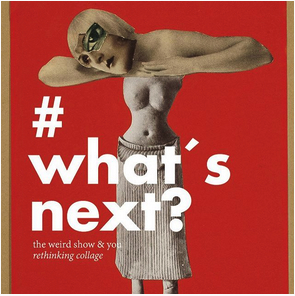 than a ton of casual “likes.” Those of us who love this practice need to push beyond the comfort of mutual praise and communicate honestly about the medium of collage (not about our political attitudes). Don’t expect the lords of social media to provide a thumbs-down button. That’s not the solution (even if they do). There needs to be the virtual equivalent of the intense coffee houses and night spots of a century ago, where artists were not shy about challenging the easy answers and safe solutions.
than a ton of casual “likes.” Those of us who love this practice need to push beyond the comfort of mutual praise and communicate honestly about the medium of collage (not about our political attitudes). Don’t expect the lords of social media to provide a thumbs-down button. That’s not the solution (even if they do). There needs to be the virtual equivalent of the intense coffee houses and night spots of a century ago, where artists were not shy about challenging the easy answers and safe solutions.
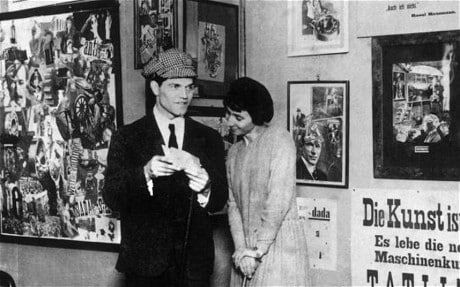 Höch, Hausmann, Schwitters, and their fellow collage “inventors” included found material contemporary with their times. There are many current practitioners who restrict themselves to “vintage” resources, and some of them avoid using anything younger than 50 years old. Whatever they choose to do is fine, but, in my opinion, 21st-century collage artists are challenged to explore the cast-off stuff of today for potential ingredients in a fresh “school of post-centennial collage” that “documents” our own culture, rather than confine themselves to curating the artifacts of our ancestors. Remember, when KS pasted down a tram ticket in place of a brushstroke, nearly a hundred years ago, he was clearly using something that he just acquired on the street. Let’s think about that when as ask ourselves, “What’s Next?”
Höch, Hausmann, Schwitters, and their fellow collage “inventors” included found material contemporary with their times. There are many current practitioners who restrict themselves to “vintage” resources, and some of them avoid using anything younger than 50 years old. Whatever they choose to do is fine, but, in my opinion, 21st-century collage artists are challenged to explore the cast-off stuff of today for potential ingredients in a fresh “school of post-centennial collage” that “documents” our own culture, rather than confine themselves to curating the artifacts of our ancestors. Remember, when KS pasted down a tram ticket in place of a brushstroke, nearly a hundred years ago, he was clearly using something that he just acquired on the street. Let’s think about that when as ask ourselves, “What’s Next?”
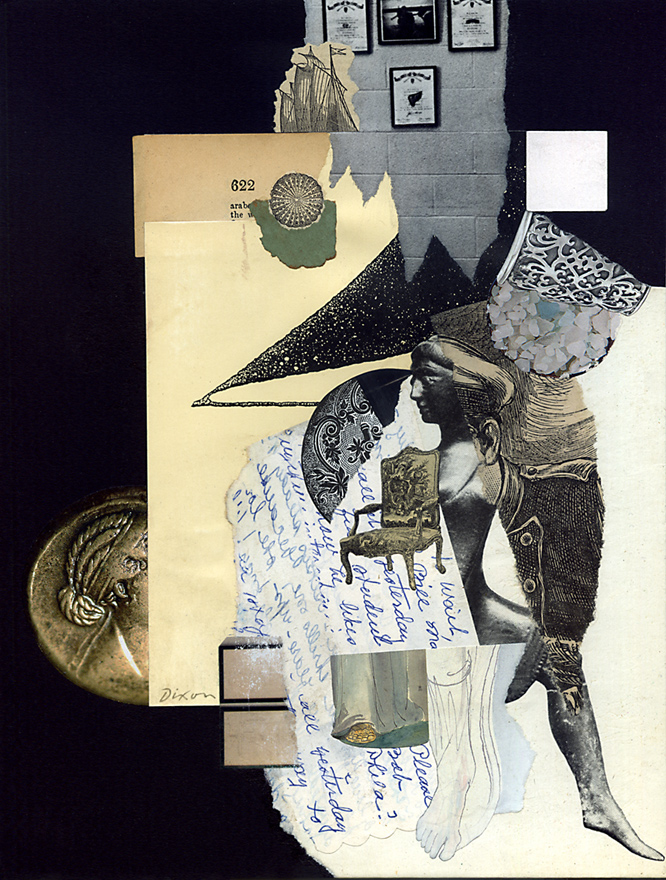
Tinged By Whispered Accounts
collage experiment in monochrome by J A Dixon
7.75 x 10.25 inches
Purchase this artwork.
Posted in Collage, Criticism, Dada, Experiments, H Höch, Ingredients, J A Dixon, K Schwitters, Merz, R Hausmann | No Comments »





































